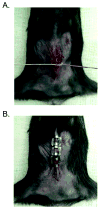Cecal ligation and puncture
- PMID: 21053304
- PMCID: PMC3058382
- DOI: 10.1002/0471142735.im1913s91
Cecal ligation and puncture
Abstract
The cecum contains a high concentration of microbes, which are a combination of Gram-negative and Gram-positive flora. These bacteria range from anaerobic to facultative aerobic to aerobic organisms. In the procedure described in this unit, the ligation of the cecum produces a source of ischemic tissue as well as polymicrobial infection. This combination of ischemic/necrotic tissue and microbial infection distinguishes this multifactorial model from a number of other bacterial sepsis models, including but not limited to: bacteremia secondary to intravenous or intraperitoneal administration; fecal administration or intraperitoneal administration of fecal or bacterial plugs; colonic stents; and bacterial abscess formation.
Figures







Similar articles
-
Cecal ligation and puncture versus colon ascendens stent peritonitis: two distinct animal models for polymicrobial sepsis.Shock. 2004 Jun;21(6):505-11. doi: 10.1097/01.shk.0000126906.52367.dd. Shock. 2004. PMID: 15167678
-
Murine model of polymicrobial septic peritonitis using cecal ligation and puncture (CLP).Methods Mol Biol. 2010;602:411-5. doi: 10.1007/978-1-60761-058-8_23. Methods Mol Biol. 2010. PMID: 20012411
-
Cecal Slurry Injection in Neonatal and Adult Mice.Methods Mol Biol. 2021;2321:27-41. doi: 10.1007/978-1-0716-1488-4_4. Methods Mol Biol. 2021. PMID: 34048005 Free PMC article.
-
Cecal ligation and puncture: the gold standard model for polymicrobial sepsis?Trends Microbiol. 2011 Apr;19(4):198-208. doi: 10.1016/j.tim.2011.01.001. Trends Microbiol. 2011. PMID: 21296575 Review.
-
Can the Cecal Ligation and Puncture Model Be Repurposed To Better Inform Therapy in Human Sepsis?Infect Immun. 2020 Aug 19;88(9):e00942-19. doi: 10.1128/IAI.00942-19. Print 2020 Aug 19. Infect Immun. 2020. PMID: 32571986 Free PMC article. Review.
Cited by
-
Apoptotic cell therapy for cytokine storm associated with acute severe sepsis.Cell Death Dis. 2020 Jul 15;11(7):535. doi: 10.1038/s41419-020-02748-8. Cell Death Dis. 2020. PMID: 32669536 Free PMC article.
-
Protection from septic peritonitis by rapid neutrophil recruitment through omental high endothelial venules.Nat Commun. 2016 Mar 4;7:10828. doi: 10.1038/ncomms10828. Nat Commun. 2016. PMID: 26940548 Free PMC article.
-
NK Cell-Derived IL-10 Supports Host Survival during Sepsis.J Immunol. 2021 Mar 15;206(6):1171-1180. doi: 10.4049/jimmunol.2001131. Epub 2021 Jan 29. J Immunol. 2021. PMID: 33514512 Free PMC article.
-
Polymerized albumin restores impaired hemodynamics in endotoxemia and polymicrobial sepsis.Sci Rep. 2021 May 25;11(1):10834. doi: 10.1038/s41598-021-90431-z. Sci Rep. 2021. PMID: 34035380 Free PMC article.
-
Targeting Gα13-integrin interaction ameliorates systemic inflammation.Nat Commun. 2021 May 27;12(1):3185. doi: 10.1038/s41467-021-23409-0. Nat Commun. 2021. PMID: 34045461 Free PMC article.
References
-
- Watanabe H, et al. Innate immune response in Th1- and Th2-dominant mouse strains. Shock. 2004;22(5):460–6. - PubMed
-
- Witek-Janusek L, Ratmeyer JK. Sepsis in the young rat: maternal milk protects during cecal ligation and puncture sepsis but not during endotoxemia. Circ Shock. 1991;33(4):200–6. - PubMed
-
- Scumpia PO, et al. Increased natural CD4+CD25+ regulatory T cells and their suppressor activity do not contribute to mortality in murine polymicrobial sepsis. J Immunol. 2006;177(11):7943–9. - PubMed
Publication types
MeSH terms
Grants and funding
LinkOut - more resources
Full Text Sources
Other Literature Sources
Medical

